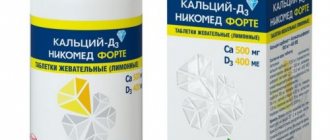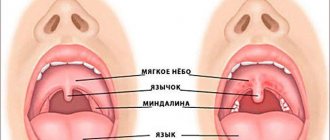Release form and its characteristics
The drug is available in the form of a powder from which a suspension is prepared. The powder has a white or milky hue with a characteristic, pronounced orange aroma. The finished suspension has a homogeneous consistency and is also white.
In pharmacies it is sold in bottles made of dark glass. Bottle volume – 100 ml.
https://www.youtube.com/watch?v=ytcopyrightru
This form of release helps you prepare the drug yourself and be confident in the timing of its preparation.
Complivit Calcium D3 for babies: instructions for use (dosage and method)
The dosage form of the drug is designed specifically for children under 3 years of age. The suspension should be taken orally during meals.
To prepare the suspension, add boiled water and cooled to room temperature (2/3 of the bottle volume) into the bottle with the powder, then mix thoroughly (1-2 minutes) and bring the suspension volume to 100 ml by adding cooled boiled water to the neck of the bottle. Stir again. The contents of the bottle should be shaken before each dose.
Recommended doses of Complivit Calcium D3 for babies:
- children under 1 year of age – 5 ml once a day (as prescribed by a doctor);
- children aged 1–3 years – 5–10 ml once a day;
- children over 3 years old - the dose is determined by the doctor.
5 ml of the finished suspension of the drug contains 200 mg of calcium and 50 IU of vitamin D3.
The duration of the preventive course is one month. Increasing the duration of taking the drug is possible after consultation with a doctor and according to his prescription.
Symptoms of a drug overdose include: vomiting, nausea, thirst, weakness, decreased appetite, dizziness, fainting, constipation, polyuria, headache, coma. Taking calcium in extremely large doses for a long time can lead to calcification of tissues and blood vessels.
In case of overdose, stop taking the drug and consult a doctor immediately. Treatment is symptomatic. The patient is prescribed glucocorticosteroids, diuretics, rehydrated and recommended to limit calcium intake from food. In especially severe cases, hemodialysis is used.
Overdose
In case of an overdose of the drug, the following undesirable effects may be observed: weakness, loss of appetite, nausea, vomiting, thirst, polyuria, constipation, dizziness, headache, fainting, coma; with long-term use – calcification of blood vessels and tissues.
Treatment: introduction of a significant amount of fluid into the body, use of loop diuretics (for example, furosemide), calcitonin, glucocorticosteroids, bisphosphonates.
If clinical overdose reactions develop, it is necessary to determine the concentration of creatinine and calcium in the blood. In case of increased concentration of calcium or creatinine in the blood serum, it is recommended to reduce the dose of the drug or temporarily discontinue therapy.
Impact on the child's body
- The drug consists of two main components, which together promote the mineralization of bone tissue.
- The following functions of the vitamin complex are:
- improvement of blood clotting;
- regulation of phosphate and calcium metabolism;
- strengthening the nervous system (including improving the transmission of nerve impulses).
- The components are also responsible for the stable functioning of the cardiovascular system.
- The overall work of Calcium and vitamin D3 promotes the production of a hormone that enhances bone resorption.
Pharmacological (immunobiological) properties
Pharmacodynamics
Complivit Calcium D3 for babies is a combined drug used to compensate for the deficiency of calcium and vitamin D3.
Calcium is necessary for the formation of bone tissue, increasing its density and mineralization of teeth. It is involved in the regulation of the conduction of nerve impulses and muscle contractions. Calcium is one of the elements in the blood clotting process. In addition, it maintains the stability of cardiac activity.
Colecalciferol (vitamin D3) is involved in the regulation of calcium-phosphorus metabolism. It increases calcium absorption in the small intestine and is necessary for bone mineralization and proper formation of teeth and skeleton in childhood.
Complivit Calcium D3 for babies reduces the secretion of parathyroid hormone, thereby reducing the leaching of calcium from the bones.
Pharmacokinetics
Vitamin D3 absorption occurs in the small intestine. Calcium is absorbed in ionized form also in the small intestine (in the proximal section). Its absorption is active, the transport mechanism is D-vitamin dependent.
Calcium is involved in the formation of bone tissue, increases its density, participates in the mineralization of teeth, in the regulation of nerve conduction and muscle contractions, in maintaining the stability of cardiac activity, and in the process of blood clotting. Vitamin D3 (colecalciferol) regulates the exchange of calcium and phosphorus in the body, increases the absorption of calcium in the intestines, promotes bone mineralization, the formation of the bone skeleton and teeth in children. The drug reduces the production of parathyroid hormone, which is a stimulator of increased bone resorption.
A two-component medicine, the medicinal effect of which consists of the effects of the active components. The medication promotes the mineralization of bone tissue, stimulates the reabsorption of phosphates in the renal system, and increases the absorption of calcium from the intestinal lumen.
The medication is able to replenish the deficiency of colecalciferol and calcium, increase bone density, reduce bone resorption, and regulate the exchange of phosphates and calcium in the body.
Calcium takes part in the process of blood clotting and the formation of the skeletal system, in the transmission of impulses along the neuromuscular pathway. Ensures stable operation and functioning of the cardiovascular system.
Colecalciferol promotes the mineralization of dental tissue and the skeletal system and participates in their formation. Ensures complete absorption of Ca from the intestinal lumen and digestive tract.
The combined use of colecalciferol and calcium enhances the production of parathyroid hormone, which acts as a stimulator in relation to bone resorption.
Detailed instructions for using the suspension
The instructions say that the drug is taken with meals. Recommended dosage:
- children under 12 months – 5 ml per day;
- for children aged 1 to 3 years – 5-10 ml per day (in one dose).
If necessary, the drug is also prescribed to older children, but only after consultation with a specialist. The dosage is prescribed individually. The duration of the course is 30 days. On the recommendation of the pediatrician, the course can be extended.
How to dilute to a suspension:
- Pre-boil the water and let it cool.
- Pour cold water into the bottle, but not all the way.
- Shake the contents well and stir for a few more minutes.
- After this, fill the bottle completely with water and shake everything thoroughly again.
Reference! Stir the contents of the bottle before each dose.
The dangers of insufficient calcium intake during pregnancy
The following symptoms may be a reason to share with your doctor suspicions about a lack of calcium in the body:
- teeth crumble and the sensitivity of the enamel increases - it begins to react sharply to cold and hot;
- nails peel and become brittle;
- hair quickly becomes dirty due to the increased work of the sebaceous glands of the scalp;
- the skin becomes dry, peeling is possible, for example, on the elbows;
- There is numbness in the lower and upper extremities, as well as in the fingers. There is a feeling of goosebumps crawling across the body;
- irritability increases, emotions are difficult to control and quickly replace each other;
- sleep is disturbed, calf muscle cramps are disturbing, sometimes even during the daytime;
- Coagulation—blood clotting—deteriorates. This is evidenced by frequent nosebleeds and bleeding gums;
- increased sensitivity to the effects of cold, expressed by chills and aches in the muscles or bones, especially the pelvis.
If at least one of the signs is detected, you should immediately visit a gynecologist to get tested and receive an appropriate prescription.
Failure to seek medical advice in a timely manner leads to complications due to hypocalcemia (calcium deficiency):
- the development of osteoporosis and osteomalacia, in which women’s bones lose strength and become fragile, which is fraught with fractures or cracks;
- early miscarriage or premature birth due to uterine hypertonicity. The muscles of those suffering from calcium deficiency are tense;
- loss of teeth during pregnancy or shortly after the birth of a baby, especially a breastfed one;
- deterioration in the appearance of pregnant women due to poor skin and hair condition;
- increased symptoms of gestosis up to eclampsia - increased blood pressure accompanied by convulsions, dangerous to the life of the mother and fetus.
Children born to women who experienced a lack of calcium during pregnancy often suffer from rickets. This disease causes disturbances in bone growth and threatens to deform the entire bone skeleton.
Video: the role of calcium in childbearing
Neither my sister nor I were prescribed calcium separately during pregnancy. Only as part of a multivitamin complex, in small quantities. Although both friends told me that it was definitely necessary, the doctor knew better that I had a lack of magnesium, but my calcium was normal. So I would advise everyone to listen to the opinion of gynecologists, and not to people who consider themselves experts without proper grounds.
Risk groups for the development of hypocalcemia
Calcium deficiency, according to medical statistics, occurs in every fifth pregnant woman. Factors that increase the risk of experiencing calcium deficiency when bearing children:
- poor nutrition. Foods that hinder the absorption of calcium: pasta;
- confectionery products and baked goods:
- spicy and fatty foods;
- carbonated drinks and coffee;
Calcium deficiency is also manifested by curvature of the legs, similar in shape to the letters “O” or “X”
Drug interactions
https://www.youtube.com/watch?v=ytaboutru
The drug reduces the absorption of digoxin, bisphosphonates, tetracycline antibiotics and iron-containing drugs (the interval between their doses should be at least 2-3 hours).
Calcium may enhance the effect of cardiac glycosides (the patient's condition and electrocardiogram should be monitored).
Primidone, barbiturates and phenytoin increase the metabolism of vitamin D3 and reduce its effectiveness. The toxic effect of colecalciferol is weakened when used simultaneously with ascorbic acid, riboflavin, tocopherol, pantothenic acid, vitamin A and tocopherol.
Calcium absorption is reduced under the influence of glucocorticosteroids. The absorption of vitamin D3 is impaired if mineral oils, colestipol or cholestyramine are used simultaneously.
The likelihood of hypercalcemia increases with the combined use of calcium and thiazide diuretics.
Vitamin D3 increases the absorption of drugs containing phosphorus and increases the risk of developing hyperphosphatemia.
The interval between taking Complivit Calcium D3 for babies and sodium fluoride should be at least 2 hours, and oral tetracyclines - at least 3 hours.
Long-term treatment with vitamin D3 and simultaneous use of antacids containing aluminum and magnesium leads to an increase in the concentration of these ions in the blood and an increased risk of intoxication.
Concomitant use with other vitamin D3 analogues and calcium-containing products increases the likelihood of hypervitaminosis D.
Side effects
Allergic reactions. When using the drug in recommended doses, no other side effects were identified. If recommended doses are exceeded or other drugs containing calcium are taken simultaneously, hypercalcemia and hypercalciuria (increased calcium levels in the blood and urine) may develop.
Possible side effects of vitamin D3 also include: decreased appetite, polyuria, constipation, headache, myalgia, arthralgia, increased blood pressure, arrhythmias, impaired renal function, exacerbation of the tuberculosis process in the lungs. Possible side effects of calcium carbonate also include: gastralgia, constipation or diarrhea, flatulence, nausea, secondary increased gastric secretion.
Allergic reactions are possible. No other side effects have been reported when the recommended doses are followed. If the dose of Complivit Calcium D3 for children is exceeded or other medications containing calcium are used simultaneously, the concentration of calcium in the urine and blood may increase.
Other possible side effects of calcium carbonate: nausea, gastralgia, flatulence, secondary increased secretion of gastric juice, diarrhea or constipation.
Vitamin D3 can cause undesirable reactions such as decreased appetite, arrhythmias, increased blood pressure, headache, polyuria, impaired renal function, arthralgia, exacerbation of tuberculosis, myalgia.
Metabolism:
- hypercalciuria;
- hypercalcemia.
Allergic responses are rarely recorded.
Terms and conditions of storage
It should be stored in places out of reach of children, as well as in places protected from direct light.
- The powder is stored at a temperature not exceeding 25 degrees Celsius.
- Ready suspension - at a temperature not exceeding 15 degrees Celsius (but do not freeze it).
The powder in a closed bottle can be stored for 2 years, and the finished suspension for three weeks.
Store at a temperature not exceeding 25 °C in a dark place. The prepared suspension should be stored in the refrigerator (at a temperature of no more than 15 ° C) in a place protected from light. The suspension must not be frozen. Keep away from children.
Shelf life – 2 years. The suspension can be stored for 20 days.
Precautions and special instructions
Sensitivity to vitamin D3 varies from child to child. Therefore, some children may develop hypervitaminosis even with normal dosage of the drug. Avoid overdose; the normal dose of vitamin D3 for children under 3 years of age is no more than 10-15 mg per year. In order to avoid an overdose, do not take other vitamin complexes, which include calcium and vitamin D3, at the same time.
Reviews
Parents who gave their children the described complex leave positive reviews online. They indicate the effectiveness of the drug. Among its advantages are its low price, the absence of preservatives and dyes, and a pleasant taste, which makes it easier for children to take. Parents of young patients indicate that this is one of the best remedies designed to prevent calcium deficiency.
Reviews of Complivit Calcium D3 for babies are very good. Mothers who gave the drug to their children speak positively about it. The syrup is effective and designed specifically for young children. It is an excellent prevention of calcium deficiency, easy to use (the suspension has a pleasant taste, a measuring spoon is included, taken once a day), rarely causes side effects and allergic reactions, and is inexpensive.
There are few negative reviews about the drug (some patients were allergic to the components of the drug).
The medication is well tolerated and is one of the main drugs that treating doctors actively prescribe to their patients for the corresponding pathology. Complivit Calcium D3 Forte contains an increased dose of colecalciferol and can be prescribed at the beginning of therapy with a subsequent transition to Complivit Calcium D3 vitamins.
Reviews about the drugs are positive; patients note an improvement in the condition of their teeth, nails, and hair during treatment. Young mothers share their experience of using the medicine for their babies, leaving positive reviews on medical thematic forums.
Interaction with other drugs
- Complivit Calcium D3 inhibits the absorption of antibiotics, as well as drugs containing ferrum. To avoid this effect, maintain intervals of at least 2-3 hours between taking medications of different groups.
- The drug can influence the action of cardiac glycosides, so in this case it is important to monitor the functioning of the child’s entire cardiovascular system. Primidone, phenytoin and barbiturates activate the metabolism of vitamin D3, thereby reducing its effect.
- Vitamin D activates the absorption of phosphorus-containing drugs, so you need to keep a break between taking them - about two hours.
- If you take vitamin D3 for a long time and combine it with antacids that contain magnesium or aluminum, their content in the blood increases. This leads to an increased risk of developing intoxication, especially for children with chronic kidney disease.
Analogs
Analogues of Complivit Calcium D3 for babies are: Calcium Vitamin D Vitrum, Calcium D3 Classic, Calcium-D-MIK, Calcium-D3 Nycomed Forte, CalciumOsteon, Complivit Calcium D3 Forte, Calcium Vitamin D3 Vitrum, Revital Calcium D, Calcium-D Nycomed, Revital Calcium D3, Calcium-D Nycomed Forte, Natekal D3, Calcium-D3 Nycomed, Natekal D, Ideos, Calcium-D3-MIK, Natemille.
Kalkohel
Natekal D3
Osteocea
Calcium D3 Nycomed
Vitrum Calcium with vitamin D3
Analogues of the complex are:
- "Calcium Vitamin D3";
- "Calcium D3 Classic";
- "Calcium D-3 Nycomed Forte";
- "Complivit Calcium D3";
- "Natekal D3";
- "Natemille" and others.










